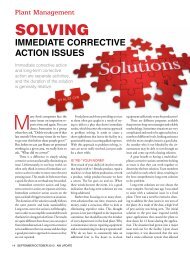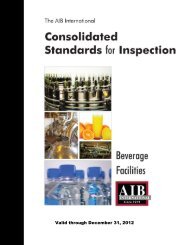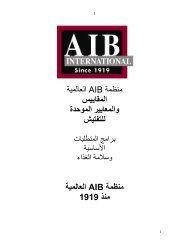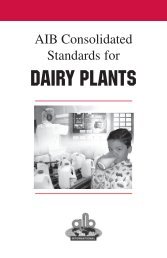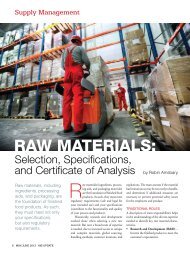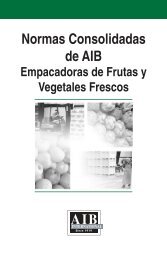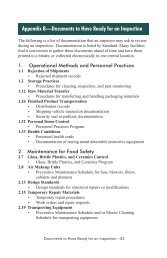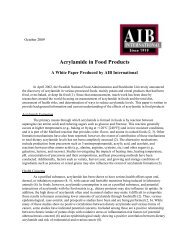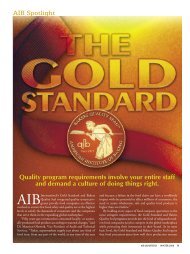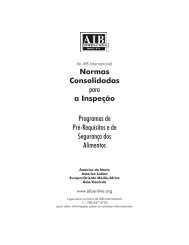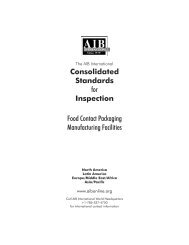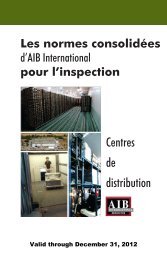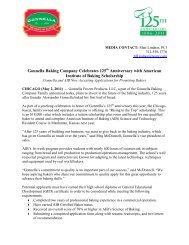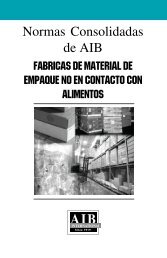Consolidated Standards for Inspection Food Distribution Centers
Consolidated Standards for Inspection Food Distribution Centers
Consolidated Standards for Inspection Food Distribution Centers
You also want an ePaper? Increase the reach of your titles
YUMPU automatically turns print PDFs into web optimized ePapers that Google loves.
Preventive Control—Risk based, reasonably appropriate<br />
procedures, practices, and processes that a person<br />
knowledgeable about the safe manufacturing, processing,<br />
packing, or holding of food would employ to signifi cantly<br />
minimize or prevent the hazards identifi ed in the hazard<br />
analysis. They are consistent with scientifi c understanding<br />
of safe food manufacturing, processing, packing, or holding<br />
at the time of the analysis.<br />
Preventive Maintenance Program—A schedule of planned<br />
maintenance activities.<br />
Prior Load Verifi cation—Documentation indicating that the<br />
same material was shipped in a bulk vessel to demonstrate<br />
that no cross contamination of non-like materials shipped<br />
in the same vessel occurred. This is typically done when a<br />
wash or dry cleaning step is not conducted between loads.<br />
Procedures—Step-by-step instructions on how to execute on<br />
a task in a Program. For example, in a facility’s Chemical<br />
Control Program, there may be a procedure on how to clean<br />
up a chemical spill.<br />
Processing Aids—<br />
• Substances that are added during the processing of a<br />
food, but are removed in some manner from the food<br />
be<strong>for</strong>e it is packaged in its fi nished <strong>for</strong>m.<br />
• Substances that are added to a food during processing,<br />
are converted into constituents normally present in the<br />
food, and do not signifi cantly increase the amount of<br />
the constituents naturally found in the food.<br />
• Substances that are added to a food <strong>for</strong> their technical<br />
or functional effect in the processing, are present in<br />
the fi nished food at insignifi cant levels, and do not<br />
have any technical or functional effect on that food.<br />
Product Area—The area close enough to the Product Zone<br />
that if an issue were found there, would impact the safety of<br />
the Product Zone.<br />
Product Zone—All food contact surfaces, and all<br />
unprotected areas directly above food contact surfaces. The<br />
Product Zone includes areas directly above exposed raw<br />
materials, work-in-process, or fi nished product.<br />
Program—A collection of documentation related to the<br />
management of an element in a facility that impacts<br />
food safety. For example, a Chemical Control Program<br />
documents everything related to the control of chemicals<br />
in a food facility. This might include procedures, policies,<br />
personnel responsible, lists of approved chemicals,<br />
storage requirements, documentation requirements, or<br />
other documents. All Prerequisites in a facility have a<br />
documented Program.<br />
Purity—The condition or quality of being pure: freedom<br />
from anything that debases, contaminates, pollutes, etc.<br />
Recall—The voluntary removal of a product from the<br />
marketplace when the product is either in violation of<br />
regulations, or regulatory agencies could take legal action<br />
against the product.<br />
38—Glossary<br />
Regrading—The process by which product that does not<br />
meet specifi cation, or is deemed substandard, is reassessed<br />
and diverted to another use <strong>for</strong> which it can meet a defi ned<br />
specifi cation or be used <strong>for</strong> another purpose.<br />
Rejection—To refuse to accept noncon<strong>for</strong>ming product.<br />
Reportable <strong>Food</strong> Registry (RFR)—An electronic portal<br />
maintained by the US FDA <strong>for</strong> industry to report when<br />
there is a reasonable probability that an article of food will<br />
cause serious adverse health consequences. This applies<br />
to all FDA-regulated categories of food and feed, except<br />
dietary supplements and infant <strong>for</strong>mula. Registered food<br />
facilities that manufacture, process, pack, or hold food <strong>for</strong><br />
human or animal consumption in the United States are<br />
subject to this act.<br />
Risk Assessment—The categorization of observations in a<br />
facility into one of fi ve categories: No Issues Observed,<br />
Minor Issues Noted, Improvement Needed, Serious, or<br />
Unsatisfactory.<br />
Security Seal—A closure to prove no tampering of contents<br />
has occurred.<br />
Sensitive—Readily affected or vulnerable. In this document,<br />
sensitive is used to describe foods that are affected by<br />
temperature, and areas of a facility that are vulnerable to<br />
pests or contamination.<br />
Severity—The level of risk within a risk assessment<br />
category (e.g., how severe is an observation within the risk<br />
category of Improvement Needed?).<br />
Single Observation—Findings (single or multiple) noted<br />
under a single Standard and related requirements. Example:<br />
All fi ndings noted in Standard 1.6 Pallets or in any of<br />
its requirements (1.6.1.1, 1.6.1.2, 1.6.2.1, 1.6.2.2) will be<br />
evaluated as one observation.<br />
Single-Service Container—A container that is designed to<br />
be used once and discarded.<br />
Socks—Typically a cloth material enclosure provided on<br />
the top of a silo, mixer, or tanker transport to allow airfl ow<br />
to occur while protecting the interior product and product<br />
contact surfaces from contamination.<br />
Supplier Guarantees/Letter of Guarantee (LOG)—A<br />
letter provided to the customer from the supplier stating<br />
that their product meets all regulatory requirements, and<br />
that they intend to continue to meet these guidelines <strong>for</strong> all<br />
products that they will produce and sell to the customer.<br />
Threat Evaluation, Assessment, and Management<br />
(TEAM)—A six step approach to threat evaluation that<br />
includes:<br />
• Identify potential threats in all aspects of the operation<br />
• Assess the threats to determine those with the highest<br />
risk (greatest negative impact)<br />
• Establish threat control measures and management<br />
control procedures to eliminate the threat or reduce<br />
the risk level



